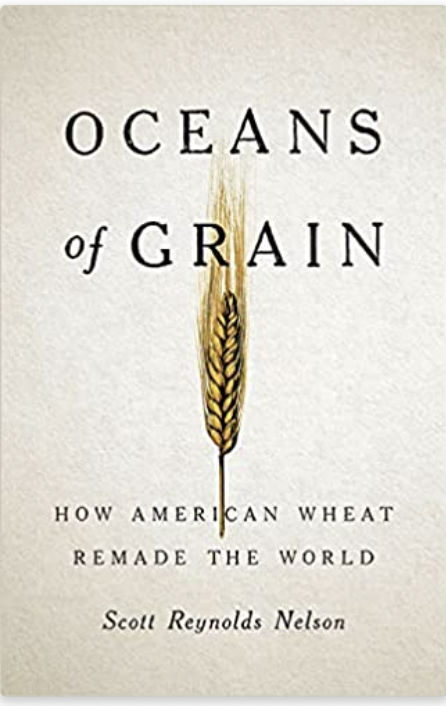
War for the breadbasket of the world



Wheat that travelled along the rivers, between ports, and across seas show how cheap American grain toppled the world’s largest empires.
In Oceans of Grain, University of Georgia academic Scott Reynolds Nelson reveals how the struggle to dominate these routes transformed the balance of world power.
Imperial Russia in the early nineteenth century fed much of Europe, through the booming port of Odesa. After the US Civil War, tons of American wheat began to flood across the Atlantic and food prices plummeted. This cheap foreign grain spurred the rise of Germany and Italy, the decline of the Habsburgs and the Ottomans, and the European scramble for empire. It was one of the crucial factors in the outbreak of the First World War and the Russian Revolution.
Russia and Ukraine, the world’s breadbasket are at war, as they account for a quarter of the world’s wheat, and roughly 12 per cent of its total calories. If the war prolongs and interrupts the spring planting season, both poor and rich countries could face food shortages and rocketing inflation.
The disruption of the grain trade may bring massive economic, political and social upheaval.
With the invention of explosives that enabled the building of the railways to the West, the US was able to transport its own heartland grain via rail and then by sea to Europe in the wake of the American Civil War. It was that sort of cheap wheat dumping that contributed to the toppling of the Russian Empire, which had previously fed Europeans from the rich soil of Ukraine.
The Arab Spring followed a global food shortage driven largely by a poor harvest in Ukraine and Russia.
Nelson gives a detailed chronicle of the “black paths” made by ancient warrior merchants, forefathers of Cossacks, called the Chumaki were there seeding those fertile plains long before the various empires that eventually controlled the region, according to Ukrainian legend. These travellers hauled leather, lead, slaves and eventually grains across the Eurasian plains, their carts making very profitable black paths as they rode.
Trade built empires as a Russian grain trader, Alexander Israel Helphand, who grew up in Odessa during the second half of the 19th century, witnessed the 1873 Agrarian crisis in which cheap American wheat, political upheaval in Russia, a financial crisis and the bursting of pan-European real estate bubble collided and led to a massive economic downturn that changed the continent.
Nelson charts wheat how and where it was grown, and how it shaped the course of history.
Wheat production, storage and transportation was the defining factor in the rise and fall of civilisations from Rome to Byzantium to the Ottoman Empire and Imperial Russia, and a key vector in the first World War, control for power of grain bottling Bosphorus that threatened the Russian grain exports exacerbating the conflict.
Catherine the Great and America’s founding fathers used debt to purchase grain and fuel empire building.
Russia did this throughout Europe, where Odesa became hub through which most of Europe’s food supply travelled, the US did mostly via westward expansion, in which wheat required less human labour than southern cotton, and became the cash crop of northern farmers and coastal industrialists.
The civil war triggered advances in production and shipment of grain, and the development of Chicago futures market, which cut the costs and risks of delivery. This along with railway and the discovery of Nitro-glycerine which allowed ports such as Antwerp to be widened and deepened, resulted in a Tsunami of US wheat into Europe. Ocean delivery was 30 times cheaper than land delivery with horses, and a deepwater port allowed an inland city like Antwerp to expand it hinterland far past its own borders in Europe where grain was unloaded, bread and many other goods were produced for burgeoning cities.
This made European peasants paid producers and consumers of cheap bread. The nature of war and supply chains shifted as the Prussians fed their armied with grain not from Germany but from Illinois via Antwerp.
Andre, Bunge, Continent, Cargill and Dreyfus, Giant grain trading houses rose and their owners became one of the richest people on the planet.
The book also tracks the end of slavery in the US and serfdom in Russia, the advent of Marxism and the first World War. The working class Europeans in the mid-19th century became shorter because white bread become more affordable as it was cheaper than brown. By 1800s America’s European migrant boom enabled by ships exporting grains returned with people who began following their dream looking for better life in the New World.
China gobbles up commodities Russia can no longer sell to the west as Nelson writes Empire may be a monopoliser of food along ancient the grain pathways that it never fully understands.
Oceans of grain reveals that amid the great powers’ rivalries, there was no greater power than control of grain.
Oceans of Grains: How American Wheat Remade the World by Scott Reynolds, Basic Books, $18.99/£25, 368 pages.
